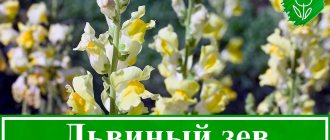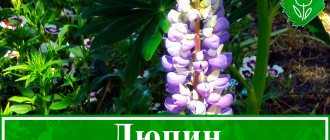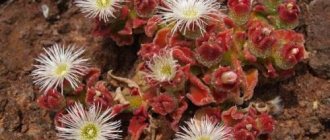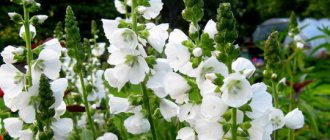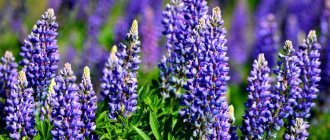Garden bindweed is a member of the genus Convolvulus of the Convolvulus family. This genus includes approximately 250 species. Their characteristic feature is the shape of the flower. In nature, these plants can be found in regions with subtropical and temperate climates. The scientific name of this genus comes from the Latin verb, translated meaning “to curl up.” The fact is that most species need support, for which they use other plants, twining shoots around them. The most common species of the genus Bindweed is field bindweed - this weed plant causes a lot of trouble for gardeners, and it is also often found in fields with agricultural crops.
Description and features of bindweed
It is a perennial or annual herbaceous plant or shrub. It reaches a height of 4 m, has creeping or erect stems, a creeping root system with thread-like roots.
Whole, alternate leaves are located on petioles. They are arrow-shaped or heart-shaped, with teeth or divided into lobes.
The flowers are arranged singly or in inflorescences in the axils of the greenery. Their shape is funnel-shaped or bell-shaped, while the blades are weakly defined. Opens its petals in the early morning, only in clear weather.
After flowering, fruits begin to form. These are boxes containing seeds. They retain germination for 2-3 years after collection.
Description of the plant
Tricolor bindweed (Convolvulus tricolor) belongs to the Convolvulus tricolor family, whose distribution area was originally in southern Europe.
It is a low plant with many lateral shoots. The shoots are long, flexible, from 50 centimeters to two to three meters long. The height of bindweed is 18-40 cm. Sometimes the plant begins to bush.
The leaves are alternate, dark green in color. They have an oblong oval or heart-shaped shape, with jagged edges.
The flower resembles a bell or funnel , the edges of which are different shades of blue and sometimes purple. The inside of the flower is white with a bright yellow center. The diameter of the flower funnel can reach 4-5 centimeters.
Bindweed tricolor is a popular flower for growing primarily because it is characterized by abundant flowering. The flowering period lasts from early summer until October. Experienced flower growers try to achieve abundant and long-lasting flowering by timely removal of wilted and faded flowers.
The fruit of garden bindweed is a capsule with one or two large seeds that are brown in color.
The root is creeping with thin thread-like processes.
Bindweed in garden design
The bindweed flower always attracts attention with its unpretentious beauty , unpretentiousness and rapid growth rate, and therefore is so popular in the design of any flower garden.
Bindweeds are grown in sunny places where it is difficult for other varieties of flowers to take root. They are usually placed in front of tall plants or among perennial varieties that do not bloom profusely.
The flower can also be used on vertical trellises , special supports, or formed into borders. It will serve as an excellent decor for fences, hide their imperfections, and look impressive on decorative figured frames.
Growing a bindweed flower is not difficult - it is one of the most unpretentious plants in this regard. This garden flower can also be grown as a potted plant, which will decorate your loggia, balcony or greenhouse not only in the summer, but also in the winter.
Types and varieties of bindweed
The genus includes 75 varieties, the identity of another 836 has not yet been precisely established. Only some species are common in Russia.
Field
Perennial or annual, reaching a length of 1-1.5 m. The flowers are small, growing along the entire smooth or fleecy stem. They come in a variety of colors: most often snow-white or pinkish, less often blue, light blue or violet. Flowering period: from the second decade of spring until frost. Reproduction occurs by seeds or root suckers.
Typically, field bindweed (ordinary) is destroyed in vegetable gardens and summer cottages, because it grows very quickly and entangles other crops, taking away their vitality. However, it also has benefits that not everyone knows about. Plants planted nearby are less likely to be affected by mold or mildew. Field bindweed also makes good mulch.
The plant also has healing properties. It perfectly helps with pathologies of the kidneys and liver, treats respiratory diseases, and cleanses the circulatory system.
Garden
A distinctive feature is the variety of contrasting and bright colors. A flowering carpet can decorate an unsightly slope on a site, an empty space or an alley. Garden bindweed is also used to decorate borders and create partitions. They can separate one part of the site from another and shade the remaining crops. Popular varieties:
| Name | Description | Flowers |
| Mauritanian | Up to 0.5 m. Usually grown in containers or hanging pots. The foliage is grayish-malachite in color. | Light lilac. |
| Double-vertex | Up to 0.4 m. In the wild, it can be found on mountain slopes, sandy shores of reservoirs, and in the steppes. Stems creeping or slightly erect. The plates are arrow-shaped, bare or pubescent. | Single, pudding. |
Tricolor
Exotic decorative vine up to 0.5 m in length. The foliage is bluish-emerald, densely planted along the entire stem. Large flowers with wavy edges reach 5 cm in circumference.
The most beautiful varieties:
- Blue and Rainbow Flash with whitish ultramarine flowers, lemon pith;
- Royal Ensign with velvety purple petals with a black tint;
- Crimson Monarch with bright raspberry buds.
Tricolor bindweed is a low-growing plant with a large number of side shoots, giving the bush the shape of a sphere. This variety looks impressive in containers on terraces, loggias, window sills, and balconies.
Convolvulus: a one-day flower
The cultivated plant bindweed is also called ephemera. All thanks to the fact that when growing it in the garden, flower growers note that each bud, after blooming, dies within a day. The genus Convolvulus has approximately 250 species and belongs to the Convolvulaceae family.
The species have a wide distribution throughout the world. Wild varieties are found in Russia as weeds. There are also numerous cultural hybrids.
In this issue we will talk about the description of bindweed, photos will help determine its appearance, and some care recommendations will help prevent it from going wild in the garden.
Description of an interesting plant bindweed
It is difficult to give a general description to a genus with almost 250 species. Bindweed is an interesting plant. It can be a grass, shrub or subshrub. Wild varieties have high winter hardiness and are less demanding.
Recently, many hybrids have been developed that require delicate care. The species diversity is great. There are evergreen varieties suitable for growing in regions with mild climates.
For areas with harsh winters, deciduous species are suitable.
The plant grows quickly. It begins to actively grow after the formation of the first true leaf. From this moment on, you need to organize proper care for the bindweed.
Root system - small roots with thread-like shoots. They are located in the top layer of soil. The stems of bindweed are erect or creeping - depending on the type of bindweed and the varietal group. They are green or woody, covered with grey-green bark. The leaf blades are heart-shaped or elongated, similar to arrows. The leaves are arranged alternately and are attached to the shoots by long petioles.
Convolvulus blooms in summer. The tubular bud, opening, turns into a funnel-shaped flower with a wide round bend. A flower lives no more than a day. But, in its place, new buds quickly form. After flowering, small boxes with seeds are formed. Planting material has a high germination rate, which can be preserved for up to 3 years.
Some varieties of bindweed are predisposed to spontaneous reproduction by self-sowing.
Please note: stores often sell bindweed seeds. When purchasing planting material, do not forget to check the expiration date.
Tricolor bindweed (Convolvulus tricolor)
An annual variety with a characteristic bud color. The funnel-shaped corolla is colored blue, yellow and white. The middle is golden. There are also other interesting hybrid species of tricolor bindweed, in particular two-color varieties. The stems are creeping, but only partially. Up to 40 cm in height. The leaf blades are oval at the bottom and lanceolate at the top. The following varieties are often grown:
Royal Ensign is a low plant. Stems up to 50 cm. Flowers dark with a yellow throat. The bud of the tricolor bindweed itself is blue.
Crimson Monarch - no different from the previous variety, except for the rich crimson flowers.
Blue Flash is a low herbaceous shrub. Tricolor bindweed with blue buds.
Semi-creeping Althaeoides (Convolvulus Althaeoides)
Large plant. Its stems reach one and a half meters in length. The leaf blades are triangular or oval shaped. The leaf is divided into lobes and covered with small hairs. The buds are deep pink.
Convolvulus cneorum (Convolvulus cneorum)
An evergreen perennial that is suitable for growing in warm regions. This is a delicate variety, demanding care and climatic conditions. The stems are long, up to 90 cm high. The leaves are covered with silvery hairs and have the shape of a spatula. There are also varieties with lanceolate plates. The flowers are snow-white, monochromatic, collected in apical inflorescences of several pieces.
Field bindweed (Convolvulus arvensis)
Variety with creeping stems. Field bindweed is a hardy plant that does not require care. It is able to adapt to unfavorable climates. The stems are long - up to two meters.
The leaves are green, with clear veins, large. The flowers are solitary or in small inflorescences, pink with white strokes. In Russia, field rootstock is often found as a wild or feral plant.
Calystegia sepium (Convolvulus or Calystegia sepium)
A rhizomatous plant with large oval-heart-shaped leaves. The length of the stems is up to 5 cm. The flowers are pink or white. The name bindweed is completely wrong for this plant. Calistegia is a completely different genus of the Convolvulaceae family. However, calistegia and bindweed are very similar to each other. But, the rootstock may have tubular flowers with a double bend.
Growing pack, taking into account growth characteristics
Bindweed is a multifaceted plant. It can be grown on terraces, open balconies, and also to create beautiful compositions in open ground. For example, fence grass or field bindweed are used to create hedges. Shrub forms and species with straight and creeping stems are grown in rock gardens.
They decorate lattice partitions, gazebos and fences. Abundant flowering will not keep you waiting. But, with proper care of bindweed, you can avoid some problems, especially spontaneous self-seeding and the wilding of cultivated varieties. Even a tricolor species can turn into a nasty weed.
It not only has small flowers, but also interferes with the development of other garden and vegetable crops.
How to grow bindweed in a pot or tub
For this purpose, both delicate and unpretentious varieties are chosen. Bindweeds are grown to decorate houses, their facades and premises.
For planting, use medium-sized containers (the optimal distance between the walls is 40-50 cm).
They are filled with a nutritious substrate based on part peat, two parts black soil, sand and three-component fertilizer. We use fertilizers rich in microelements.
Caring for bindweed in a pot is easy. Organize watering as the soil dries. Add complex fertilizers every 2-3 weeks. Liquid formulations are suitable for indoor flowering plants.
Place the planter in a bright, well-lit area. You can leave it unattended on the balcony, as the plant easily tolerates high temperatures. However, it must be hidden from the midday sun.
Otherwise, the stems and leaves will be burned.
Potted plants need to be transplanted into a new container every year. They do this in the spring. Take a container an order of magnitude larger than the previous one. Use the same soil as when planting.
Features of growing bindweed in the garden
To organize care, you need to know that bindweed is a light-loving plant. The best option is to plant it in the western part of the garden so that it is not exposed to direct sunlight at midday. In winter, perennials often lose their leaf mass. But in the spring, the plant quickly recovers.
Thanks to their rapid growth, bindweeds can be beautiful annuals. In this case, either use delicate varieties or treat the soil after them.
Young plants need to be watered. Immediately after planting, bindweeds need moisture. But, don't use too much water. In swampy soil, fungal development begins in the rhizome. Adult bindweeds are watered only during drought.
Be sure to remove old and wilting leaves. Periodically you need to get rid of faded buds. Don't forget to remove old, withered stems.
Reproduction of bindweed
Seeds are used to propagate bindweed. They remain viable for 2-3 years from the moment of collection. You can buy them at a flower shop or collect them from your own plantings. Often bindweed seeds are sold in the spring, before the start of the gardening season, in chain grocery stores.
To plant seeds, take small containers and fill them with compost. For me personally, they sprouted in regular soil within a week. It is better to sow in spring, in March. It is recommended to keep it at a temperature of +18 degrees until germination.
I buried my bindweeds 1.5 cm deep into the ground. I recommend planting the plants at the end of spring. I did not dive, since the seeds were placed in different containers.
Before planting, the bindweed should be allowed to get used to the new growing conditions a little, and only then transplanted into open ground.
As for home and tub bindweeds in a pot, they are propagated in the same way, planting seeds in compost.
How to get rid of bindweed on your property
Bindweed occurs as a weed. It is so malicious that it prevents other plants from growing and developing. Bindweed strangles other crops by wrapping strong shoots around their stems.
Therefore, if a plant appears on your site, you need to know how to get rid of it. Otherwise, if the plant is not removed at the first sprouts, it will quickly populate the entire garden. It causes a lot of harm to cultivated and fruit-bearing perennials.
Can affect flowering and fruit formation of all annuals.
To get rid of bindweed, you need to determine the place where it grows. If the plants are single, then this is easy to do. To do this, they either dig up the soil and remove all the roots of the perennial, or treat it with special compounds, including:
Plants need to be treated point by point. The compositions are suitable for getting rid of several bindweeds. If a perennial has colonized a large area or has multiplied spontaneously in the garden, then radical measures are needed:
In spring or autumn, dig up all the places where bindweed lesions have been identified. Many varieties of the tricolor variety and field bindweed are predisposed to spontaneous colonization.
The dug up soil is covered with non-woven material that does not transmit light. With such shelter, some of the bindweeds should die within 1 month. This year I do not recommend planting anything other than mustard.
Cultivated plants can be planted next year.
Source: https://cvetochkino.ru/?p=1349
Growing bindweed from seeds
The flower is propagated only by seeds. They can be sown directly into an open area or planted as seedlings. Pre-growing from seeds indoors is preferable, so the bush will grow faster and bloom more profusely.
Sowing of seedlings is carried out in March:
- Leave the seeds in water for a day.
- Place in separate containers with soil mixture for flowering plants. It is not advisable to plant in common containers, because bindweed does not tolerate transplantation well.
- Deepen the seed and cover it with a thin layer of soil.
- Keep pots at +18…+20° C.
- Apply mineral fertilizers. Water regularly, not allowing the soil to dry out.
- The first shoots will sprout after a couple of weeks.
Drop off point
Garden tricolor convolvulus is usually grown in open areas. If desired, it can be grown at home, but it is worth considering that this variety of bindweed behaves like a creeping plant. It is more suitable not for vertical gardening, but for container planting. When grown in garden plots, it can be used for border or carpet planting. The root system grows well, the flower tends to occupy free areas. Therefore, you need to clearly define the boundaries and maintain them with regular pruning.
Since bindweed is absolutely unpretentious and easily adapts to almost any conditions, different types of soil and areas with different light intensities are suitable for it.
The ideal place is:
- sunny open areas;
- drained loamy soil.
It calmly tolerates shading and minor droughts, although in such conditions fewer buds are formed, and the intensity of the color of the petals is somewhat reduced.
Planting bindweed in the garden
Before planting, seedlings must be hardened off. To do this, she is taken outside every day, starting from 10 minutes, gradually increasing the time of “walks”. Thanks to this, the bindweed will have a stronger immune system and will be able to resist various diseases.
Landing dates
Planting is done after the snow melts, when the risk of frost returns disappears. This usually happens in mid-May to the first half of June.
Landing technology
It is necessary to choose a sunny place. Only in this case will it bloom magnificently and for a long time. The flower is unpretentious to soil mixtures, but grows better on a permeable, loamy substrate. Landing occurs as follows:
- Dig up an area with peat (2-3 kg per 1 sq.m).
- Level the ground surface.
- Move the plants into holes located at a distance of 20-25 cm from each other using the transfer method. Before transplanting, water the seedlings (it will be easier to remove the bushes from the pots).
- Moisten thoroughly.
Caring for bindweed
Planting and further care of the plant are simple. It is enough to fulfill some requirements:
| Criterion | Recommendations |
| Watering | Regular and plentiful. If there is a lack of moisture, the flower will drop its petals. When moisturizing, make sure that there is no stagnation of liquid. Because of this, a fungal infection may begin to develop. |
| Top dressing | If growth is slow, add wood ash or fertilizer for flowering plants. For example, Nitrophoska, Agricola. |
| Weeding | In the first 2-3 weeks after planting. When the bushes get stronger, they will be able to suppress weeds. |
| Formation | It is necessary to create a support so that the bindweed can entwine it during active growth:
When a flower grows in the wrong direction, prune it. |
After flowering
In Russia it is grown as an annual plant. Therefore, in mid-autumn it is necessary to dig it up with its rhizome and dig up the area. Since the flower has the ability to self-sow, new specimens will begin to form in the same place next season.
Feeding and care
It is very easy to care for the plant; it is not particularly demanding, so even a novice gardener can easily grow it. But we will still tell you what a plant may need during growth and flowering.
- firstly, its tropical origin means that star bindweed loves the sun. Therefore, we plant it only in the sun, no shade. The soil needs to be neutral - loam and sandy loam soil are perfect for these purposes. The plant does not mind summer heat, direct sunlight does not have any negative effect on its growth. But you still cannot do without regular watering; in this case, the flowering will be more luxuriant. But you should know that with excessively abundant watering, the leaf mass will increase, but the flowering will, alas, be weak. Or it won't exist at all;
- secondly, fertilizers of organic origin should be used as fertilizing; bindweed somehow has a “negative” attitude towards mineral fertilizing. And among organic ones, it is best to use rotted compost, peat and wood ash. It is best to add ash at the beginning of the formation of flower buds - they will be more lush and abundant;
Organic fertilizer
- and thirdly, it is necessary to constantly loosen the soil after each watering or rain. Don’t forget to constantly remove weeds; if you don’t want to bother with weeding, you can mulch the ground. This step will solve several problems at once: cope with weeds, retain moisture in the soil.
The task of care is made much easier by the fact that in the case of star bindweed, dried inflorescences do not need to be removed from the plant.
The bindweed needs to be shown the direction in which its vines should crawl. Otherwise, instead of an even flower carpet, you can end up with a chaotic pile skewed in one direction. In addition, excessive density begins to interfere with neighboring plants, so you will also have to worry about pruning the bindweed.
Insecticide
The plant shows amazing resistance to various diseases and pests. For example, he can only get sick if there is a plant affected by the disease in the neighborhood. The treatment is simple - removal of the affected parts of the plant and treatment with insecticidal preparations. The plant can also be treated with them as a prophylactic agent.
Diseases and pests
Bindweed is a robust plant that is rarely affected by disease or insects. Sometimes, in the absence of proper care, a flower gets powdery mildew. It can be identified by the following signs:
- White powdery spots containing fungal spores. After a while, they begin to secrete liquid drops that resemble dew.
- Early petal fall.
- Curling and wilting of foliage.
- Stopped development.
The disease most often occurs due to errors in care:
- high humidity;
- aphid damage;
- excess nitrogen in the soil;
- excessive planting density.
Fungal spores can also enter with water during watering or from other plants through the wind, through a person or undisinfected equipment.
If the damage is severe, the flower dies; in the initial stages of the disease, it can still be saved:
- Remove affected areas.
- Spray with soda ash (2-3 g per 1 liter of water) or soap-copper solution (25 g of green soap and 2.5 g of copper sulfate per 1 liter of liquid).
- Treat the bush itself, containers, and soil with Vitaros, Fundazol, Topaz, Hom or other fungicides.
Occasionally, aphids begin to live on bindweed. Insect pests can be recognized by the following signs:
- wilting of young leaves and buds;
- dark spots (punctures from proboscis);
- syrupy liquid on the aerial part;
- the appearance of ants near the plant (they are attracted by sticky mucus).
You can destroy the insect in the following ways:
- wipe the above-ground part with a cloth soaked in soapy water;
- purchase larvae of red ants or ladybugs at a gardening store (these are natural enemies of the pest);
- use purchased drugs: Commander, Bankol, Vertimek and others.
Medicinal properties
It is not decorative bindweed that has medicinal properties, but the common field Convōlvulus Arvēnsis, which is more often called birch. These are perennial bindweeds that are destructive to the garden, but their roots, herbs and seeds are used in folk medicine.
Preparations prepared from birch bindweed are used to treat gastritis, enterocolitis, as an analgesic, diuretic and laxative.
Attention. Field bindweed is poisonous, so preparations from it should be used under medical supervision.
Recipe:
- Grind dried rhubarb roots and birch seeds in a coffee grinder in equal proportions.
- Take 4 g per day as a laxative.
The above-ground part is harvested for medicinal purposes at the flowering stage. The roots are dug up in early spring or autumn. The raw materials are washed from the ground and dried well under a roof or in an electric dryer at a temperature of 40-45 degrees. Can be stored for no longer than a year.
Recipe with bindweed for toothache:
- pour a tablespoon of ground root into a glass of boiling water;
- leave for 20-25 minutes;
- rinse your mouth.
Recipe for treating wounds:
- fill a half-liter glass jar 2/3 with leaves and flowers cut into pieces;
- pour vodka up to the neck;
- put in a dark place and wait 14 days.
Before use, the tincture is diluted with boiled water (a tablespoon per 100 ml) and used for compresses.
Mr. Summer Resident informs: how to get rid of field bindweed
Wild bindweed can be a problem in your garden. By entwining other plants, it suffocates them and prevents them from growing normally.
A fast-growing weed should be destroyed while it is still young. It must be completely torn out without leaving roots in the ground. New shoots can begin to form from them. Collect all parts of the plant carefully so that the seeds do not scatter and burn. If this does not help, then it is advisable to use poisonous drugs: Linder and others.
To avoid unwanted growth of bindweed in the future, dig up all the soil in the spring, destroying the remaining roots. After this, cover the area with material that does not allow light and air to pass through. Under such conditions, the remaining parts of the plant will die. Green manure also helps prevent unwanted weed growth. For example, white mustard.



